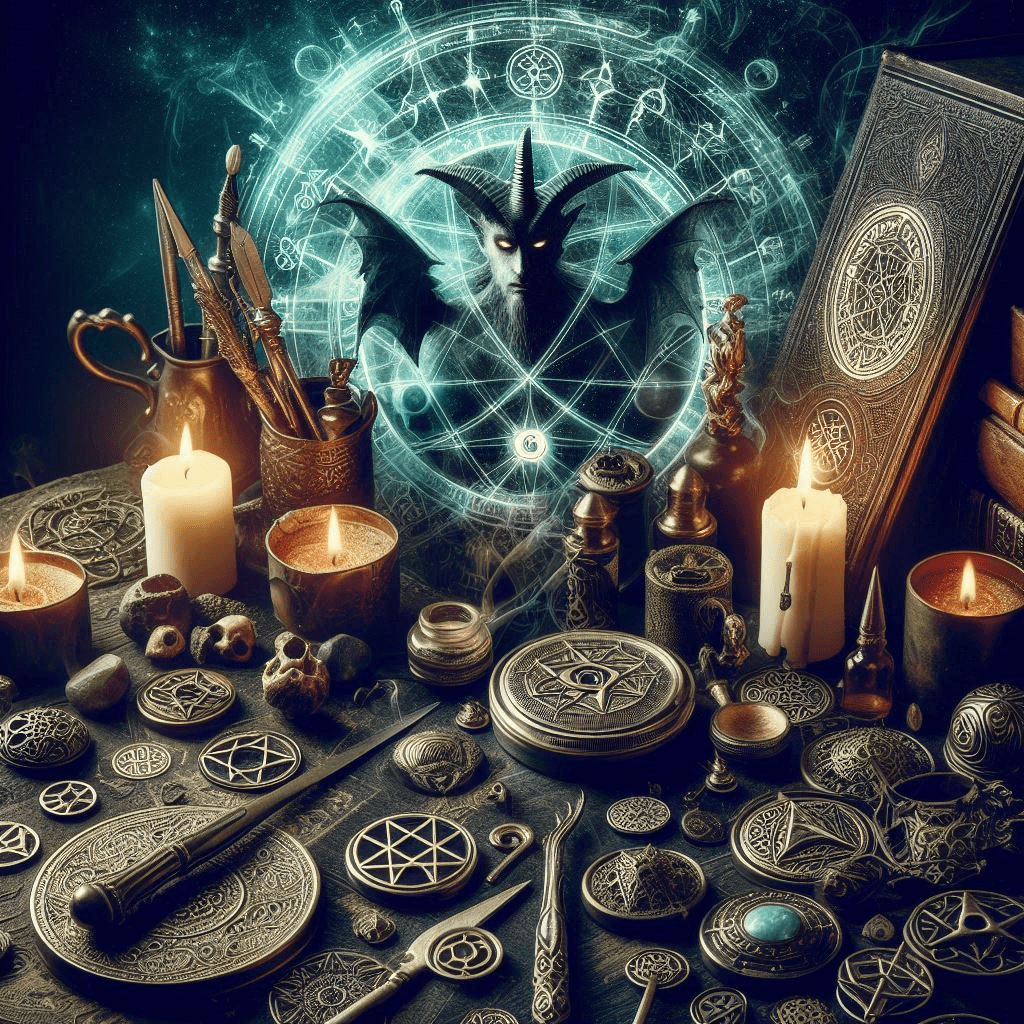Your cart is currently empty!

Practical Demon Keeping: A Modern Guide to Ancient Practices
In the realm of mystical and magical practices, demon keeping has long been shrouded in mystery and intrigue. While the concept might evoke images of dark rituals and ancient tomes, practical demon keeping in the modern age is less about summoning malevolent spirits and more about understanding and harnessing energies—both external and internal. This blog entry explores the fascinating world of practical demon keeping, offering insights and guidance for those curious about this esoteric yet surprisingly relatable practice.
A Fresh Perspective on Demons
Have you ever felt overwhelmed by inner struggles, recurring fears, or the sense that untapped potential lies just beneath the surface? What if there were a way to channel these forces, transforming them from obstacles into allies? This is where the modern interpretation of demon keeping comes into play. In contemporary spirituality, demons are often seen as symbolic representations of our inner world rather than literal beings. These energies can reflect our deepest fears, unacknowledged desires, or even powerful but unrefined talents waiting to be harnessed.
Historically, the concept of demons has varied widely across cultures. In some traditions, demons were seen as malevolent spirits to be warded off, while in others, they were viewed as powerful entities capable of aiding those who approached them respectfully. For example, in ancient Mesopotamian lore, demons could serve as protectors as well as harbingers of misfortune. Similarly, in Japanese folklore, oni (often interpreted as demons) could represent both destructive chaos and protective guardians depending on the context. Today, practitioners are rediscovering these ancient beliefs and reframing them in a modern context, focusing on personal growth and self-discovery rather than fear or domination. By engaging with these energies thoughtfully, practitioners can uncover transformative insights about their psyche and life path.
The Role of Intent and Respect
One of the foundational principles of practical demon keeping is the importance of intent and respect. Whether you view demons as literal entities or as symbolic forces, they represent power that must be approached with care. Clear intent is essential: what do you hope to achieve through this practice? Are you seeking understanding, strength, or resolution of a personal challenge? Without a defined purpose, it’s easy for energy to become chaotic or unproductive.
Respect is equally critical. Think of these energies as you would a natural force like fire or water—invaluable when properly harnessed but potentially dangerous if approached recklessly. Respect manifests in several ways: setting clear boundaries, ensuring your actions align with ethical principles, and maintaining a sense of humility. For example, if you’re working with the symbolic demon of fear, approach it as a teacher rather than an enemy. Ask yourself what this fear can teach you about your vulnerabilities and strengths.
Practical demon keeping isn’t about control or domination but about fostering a balanced and mutually beneficial relationship with the energies you’re working with. Consider this practice an opportunity to collaborate with the aspects of yourself that often go ignored, learning how to transform challenges into sources of empowerment.
Tools and Techniques for Modern Practitioners
Practical demon keeping often involves a blend of ancient traditions and modern adaptations. Here are some common tools and techniques to explore:
1. Sigils and Symbols
Creating and using sigils is one of the most accessible entry points for beginners. Sigils are symbols imbued with specific intent, acting as focal points for energy and concentration. To create a sigil, start by writing a clear intention (e.g., “I will overcome my fear of public speaking”). Remove duplicate letters and rearrange the remaining ones into a unique design. This symbol can then be visualized, drawn on paper, or carved into candles to aid in focusing your energy.
For instance, if you’re working to address procrastination, you might design a sigil representing productivity and focus. You can draw this sigil on a small piece of paper and carry it with you or place it on your workspace as a reminder of your intent.
2. Meditation and Visualization
Meditation helps practitioners ground themselves, clear their minds, and prepare for deeper work. Visualization, on the other hand, is a powerful tool for connecting with the energies you’re working with. For example, you might visualize your “demon” as a guide offering insight or strength. Picture its form, personality, and presence—not as something to fear but as a collaborator in your growth.
Consider a visualization exercise where you imagine meeting the “demon” of self-doubt in a serene setting. Instead of engaging in conflict, you might envision sitting with this force and asking it what it needs or why it appears. Such interactions can reveal profound insights and help you reclaim inner confidence.
3. Rituals and Offerings
Simple rituals can help you set the tone for your practice and establish respectful communication with the energies involved. This might include lighting candles, burning incense, or offering small tokens of appreciation, such as food, herbs, or written affirmations. For example, if you’re seeking clarity from the symbolic demon of confusion, you might light a white candle and burn sage while setting an intention for mental clarity.
More elaborate rituals might include creating an altar with symbols or items that resonate with the energy you’re working with. If working with the demon of anger, consider placing items like red candles or stones like carnelian or garnet, which are associated with transformation and grounding.
4. Protective Measures
Safety is paramount in any spiritual practice. Protective measures might include creating a protective circle using salt or stones, wearing an amulet, or invoking the assistance of a protective deity or spirit. For example, some practitioners call upon Archangel Michael or similar protective figures to guard their space and intentions during their work.
Another method is visualizing a sphere of white light surrounding you, creating a safe and sacred space for your practice. This can be particularly helpful if you’re feeling uncertain or vulnerable as you explore new energies.
5. Journaling and Reflection
Documenting your experiences is a valuable way to track your progress and deepen your understanding. Journaling allows you to reflect on the insights gained through meditation, rituals, or interactions with symbolic energies. Over time, these reflections can reveal patterns and growth that might otherwise go unnoticed.
For example, you might write about your interactions with the symbolic demon of anxiety. Over weeks or months, you could notice how your responses evolve, gaining greater control and understanding of this force within your life.
Ethical Considerations in Demon Keeping
As with any spiritual practice, ethical considerations are vital. Practical demon keeping should never be used to harm others, manipulate situations unethically, or seek power for its own sake. Instead, practitioners are encouraged to use this practice as a tool for personal growth, self-discovery, and empowerment. Always approach your work with integrity and ensure your actions align with your values.
It’s also essential to be mindful of cultural appropriation. Many practices associated with demon keeping have roots in specific cultural traditions. While it’s wonderful to learn from these traditions, practitioners should approach them with respect, avoiding misrepresentation or superficial engagement. For example, if drawing inspiration from Hindu or African spiritual systems, take the time to understand their historical and cultural significance rather than using them decoratively.
A Journey of Transformation
Practical demon keeping is not a quick fix or a superficial hobby; it’s a journey of self-discovery and empowerment. By engaging with these ancient practices in a modern context, you can gain deeper insights into your own psyche, overcome personal challenges, and harness your inner strength. The path may be challenging at times, but it is also profoundly rewarding.
For those intrigued by the mystical allure of demons or simply curious about exploring new spiritual paths, practical demon keeping offers a unique opportunity to engage with the mysteries of the self. For example, someone wrestling with feelings of inadequacy might find that practical demon keeping helps them confront and ultimately dissolve these feelings, replacing them with confidence and purpose.
Remember, the journey is yours to shape—approach it with an open mind, a clear heart, and a healthy respect for the powerful energies you’ll encounter. So, are you ready to embrace your inner strength and navigate the enigmatic world of practical demon keeping? Start small, stay curious, and let the journey unfold. Who knows what transformative discoveries await you?






